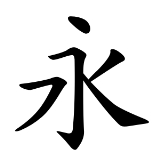
Eight Principles of Yong
Encyclopedia
Stroke order animated and in color gradation from black to red (right)  The strokes numbered Where there are multiple numbers in an area, the strokes overlap briefly and continue from the previous number to the next. The strokes together, and separated Sequence numbers and stroke directions in red |
The Eight Principles of Yong explain how to write eight common strokes in regular script
Regular script
Regular script , also called 正楷 , 真書 , 楷体 and 正書 , is the newest of the Chinese script styles Regular script , also called 正楷 , 真書 (zhēnshū), 楷体 (kǎitǐ) and 正書 (zhèngshū), is the newest of the Chinese script styles Regular script , also called 正楷 , 真書 (zhēnshū), 楷体 (kǎitǐ) and 正書 (zhèngshū), is...
which are found all in the one character, . It was traditionally believed that the frequent practice of these principles as a beginning calligrapher
Calligraphy
Calligraphy is a type of visual art. It is often called the art of fancy lettering . A contemporary definition of calligraphic practice is "the art of giving form to signs in an expressive, harmonious and skillful manner"...
could ensure beauty
Beauty
Beauty is a characteristic of a person, animal, place, object, or idea that provides a perceptual experience of pleasure, meaning, or satisfaction. Beauty is studied as part of aesthetics, sociology, social psychology, and culture...
in one's writing.
The Eight Principles are influenced by the earlier Seven Powers by Lady Wei Shuo
Wei Shuo
Wei Shuo , courtesy name Mouyi , sobriquet He'nan , commonly addressed just as Lady Wei , was a Chinese calligrapher of Eastern Jin, who established consequential rules about the regular script. Her famous disciple was Wang Xizhi....
of Eastern Jin. Publications on the Principles include:
- The Praise to the Eight Principles of "Yong" by Liǔ ZōngyuánLiu ZongyuanLiu Zongyuan , courtesy name Zihou , was a Chinese writer who lived in Chang'an during the Tang Dynasty. Liu was born in present-day Yongji, Shanxi, along with Han Yu, he was a founder of the Classical Prose Movement...
of the Tang DynastyTang DynastyThe Tang Dynasty was an imperial dynasty of China preceded by the Sui Dynasty and followed by the Five Dynasties and Ten Kingdoms Period. It was founded by the Li family, who seized power during the decline and collapse of the Sui Empire...
. - Explanations to the Eight Principles of "Yong" by Lǐ Pǔguāng of the Yuan DynastyYuan DynastyThe Yuan Dynasty , or Great Yuan Empire was a ruling dynasty founded by the Mongol leader Kublai Khan, who ruled most of present-day China, all of modern Mongolia and its surrounding areas, lasting officially from 1271 to 1368. It is considered both as a division of the Mongol Empire and as an...
. Lǐ provided two-character metaphorMetaphorA metaphor is a literary figure of speech that uses an image, story or tangible thing to represent a less tangible thing or some intangible quality or idea; e.g., "Her eyes were glistening jewels." Metaphor may also be used for any rhetorical figures of speech that achieve their effects via...
ical names.
Table of naming usages
| Stroke | (pinyin | Lǐ's name | Additional description | ||
|---|---|---|---|---|---|
| 1 |  |
Cè, (/) "Sideway" | Diǎn, (/) "Dot" | Guài Shí, "Strange stone" | Tiny dash, speck. |
| 2 |  |
Lè, "Bridle" | Héng, "Horizontal" | Yù Àn, "Jade table" | Rightward stroke. |
| 3 |  |
Nǔ, , "Crossbow"; Nǔ, "Strive" |
Shù, ( "Erect"; Tiěchǔ, (/) "Iron staff" |
Tiězhù, (/) "Iron pillar" | Downward stroke. |
| 4 |  |
Tí, "Jump" | Gōu, "Hook" | Xièzhuǎ, "Pincer of a crab" | Appended to other strokes, suddenly going down or going left only. |
| 5 |  |
Cè, "Horsewhip" | Tí, "Raise"; Tiāo, "Lifting off" |
Hǔyá, "Tiger's tooth" | Flick up and rightwards. |
| 6 |  |
Lüè, "Passing lightly" | Wān, (/) "Bend, curve" | Xījiǎo, "Horn of rhinoceros" | A tapering thinning curve, usually concave left (convex outward right) and with fast speed as if skimming. |
| 7 |  |
Zhuó, "Pecking" | Piě, "Throw away, slant"; Duǎn Piě "Short slant" |
Niǎo Zhuó, / "Bird pecking" | Falling leftwards (with slight curve). |
| 8 |  |
Zhé, "Dismemberment" | Nà, "Pressing forcefully"; Pō, "Wave" |
Jīndāo, "Golden dao Dao (sword) Daois a category of single-edge Chinese swords primarily used for slashing and chopping , often called a broadsword in English translation because some varieties have wide blades. In China, the dao is known as one of the four major weapons, along with the gun , qiang , and the jian , and referred... (knife)" |
Falling rightwards (fattening at the bottom), where the end point is "as sharp as a knife" (hence the name "Dismemberment"). |
Note:
 - Xié 斜 is sometimes added to the 永's strokes. It's a concave Shù falling right, always ended by a Gōu, visible on this image.
- Xié 斜 is sometimes added to the 永's strokes. It's a concave Shù falling right, always ended by a Gōu, visible on this image.
